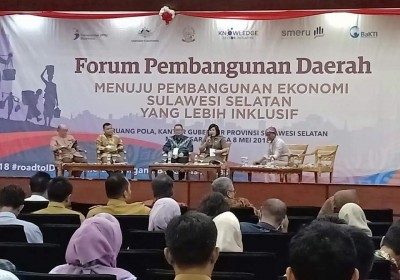Inclusive Development: A Solution to Reduce Economic Gaps
June 11, 2018
Road to IDF Regional Development Forum in Makasar, South Sulawesi, Tuesday, May 8, 2018.
Makassar, the capital of South Sulawesi province is not so common in terms of economic development. The poverty rate here is low, while economic growth is high. However, the high economic growth is not able to suppress the unemployment rate, which is very high, reaching 12 percent. Usually, a low poverty rate is the result of a low unemployment rate.
“This is probably because the unemployed in Makassar are economically supported by their extended family. They live with relatives and although they are not employed they do not belong to the poor. They are simply counted as unemployed, "explained Minister of Development Planning / Head of Bappenas, Prof. Dr. Bambang PS. Brodjonegoro in his address at the Road to IDF Regional Development Forum, Tuesday, May 8, 2018.
The forum was organized jointly by the South Sulawesi Provincial Government and The SMERU Research Institute and BaKTI Foundation, and supported by Bappenas RI and the Australian Government through the Knowledge Sector Initiative (KSI). The theme was "Towards a More Inclusive Economic Development of South Sulawesi" to facilitate policy dialogues, exchange of good practice information, and experience among policy makers, researchers, development actors, and other stakeholders. This dialogue was expected to provide inputs for policy formulation and implementation of inclusive economic development in South Sulawesi.
Another problem is that the high economic growth in South Sulawesi is not evenly distributed. Three districts of Pangkep, Jeneponto and Luwu Utara are still high in terms of poverty, the rate of which stands at around 15 percent. This is why South Sulawesi has not yet become an inclusive economic development area as development has not yet been equitable. Not only South Sulawesi, there are many other areas in Indonesia that have not implemented inclusive economic development.
The inclusive economy is indeed a hot topic for the three sectors driving economic growth in Indonesia, from government, private sector, to civil society. Inclusive economic development is predicted to benefit all levels of society without exception.
Based on the inclusive development index (IDI) released by the World Economic Forum (WEF) in 2017, Indonesia is ranked 22nd out of 79 developing countries. Indonesia is under Thailand and Malaysia, which are rank 12 and rank 16.
Addressing this, President Joko Widodo instructed his entire administrationto focus on reducing development inequality. Inclusive and equitable development becomes the policy in the National Medium Term Development Plan for 2015-2019. This can be achieved but implementing three policies. First are the policies to strengthen employment sector to address the gap between income groups. Second are the policies to increase of inter-regional connectivity to reduce regional disparities. And the last one are those which increase access to land and capital to resolve land ownership gaps.
"The policy direction for regional development will strengthen and accelerate development in Eastern Indonesia," said Bambang.
These policies, said the Minister of PPN, should also complemented with the effort to maintain growth in Java-Bali and Sumatra regions, while improving the performance of regional growth centers Kalimantan, Sulawesi, Nusa Tenggara, Maluku and Papua. All this is expected to help Indonesia achieve equitable development. Development that is not only enjoyed by the people of Java, but throughout Indonesia.
And eventually inequality in Indonesia cn be reduced. Based on data from Bappenas, the open unemployment rate that reached 6.18 percent in 2015 decreased to 5.3 percent in February 2017 . The poverty rate of 11.22 percent in 2015 dropped to 10.6 percent in March 2017. Gini ratio decreased by 0.408 in 2015 to 0.393 in March 2017.
Bambang expressed optimism that the target of reducing inequality contained in the national development agenda as per President Jokowi's instruction can be met. President Jokowi's instructed that the open unemployment rate should drop to 4-5 percent, the poverty rate to 7-8 percent, and the gini ratio to 0.36 percent by end of his first administrative term.
The Government of Indonesia's efforts to address this development gap are supported by the Australian Government. Indonesia has been an Australian development partner since it declared its independence many years ago.
"One of the important focuses of development cooperation between the two countries is that Australia supports Indonesia to address the development gap between provinces and between rural and urban areas," said Australian Consul-General Richard Mathews in Makassar, quoted by Antara News Agency.
The governments of Indonesia and Australia will be jointly seeking the solutions to address the gaps and to realize inclusive development in Indonesia through the Indonesia Development Forum 2018. The activity was initiated by the National Development Planning Agency (Bappenas) of Indonesia and the Australian Government through Knowledge Sector Initiative (KSI).
This year's IDF peak event will be held on July 10-11 and will bring up the theme of "Breakthrough to Overcome Inequality among Areas throughout the Archipelago". IDF 2018 will explore various key issues and challenges in the effort to tackle the economic and human development gaps in various regions of Indonesia. The output will be in the form of recommendation to inform the developent of National Medium Term Development Plan (RPJMN) of 2020-2024.
Indonesia’s Research Institutions Supporting the Development of the Electric Vehicle Industry
Indonesian Muslim Fashion and Cosmetics IKMs Shine at Dubai World Expo 2020
Govt Steps Up UMKM Transformation Efforts in the Midst of Pandemic Slowdown
Govt Encourages Promotion of IKM Products in Digital Era
Government Begins Developing Maritime Training Center in Makassar
Tweets by IDDevForum
